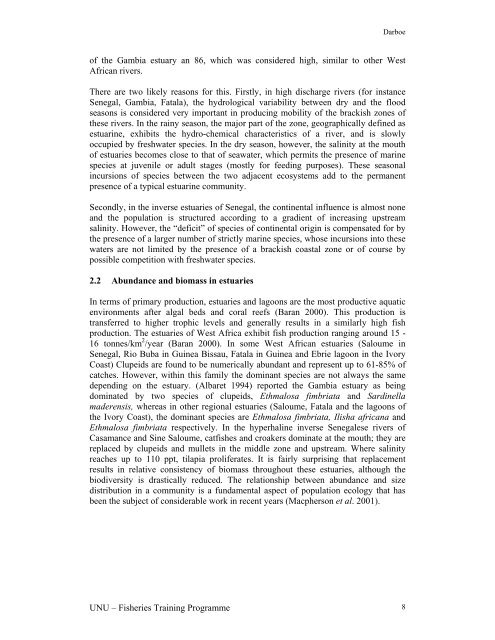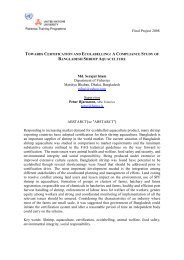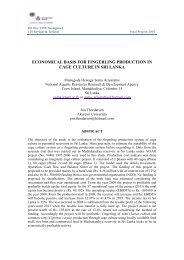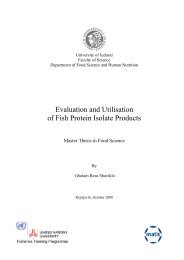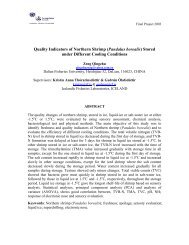Fish species abundance and distribution in The Gambia estuary
Fish species abundance and distribution in The Gambia estuary
Fish species abundance and distribution in The Gambia estuary
You also want an ePaper? Increase the reach of your titles
YUMPU automatically turns print PDFs into web optimized ePapers that Google loves.
Darboeof the <strong>Gambia</strong> <strong>estuary</strong> an 86, which was considered high, similar to other WestAfrican rivers.<strong>The</strong>re are two likely reasons for this. Firstly, <strong>in</strong> high discharge rivers (for <strong>in</strong>stanceSenegal, <strong>Gambia</strong>, Fatala), the hydrological variability between dry <strong>and</strong> the floodseasons is considered very important <strong>in</strong> produc<strong>in</strong>g mobility of the brackish zones ofthese rivers. In the ra<strong>in</strong>y season, the major part of the zone, geographically def<strong>in</strong>ed asestuar<strong>in</strong>e, exhibits the hydro-chemical characteristics of a river, <strong>and</strong> is slowlyoccupied by freshwater <strong>species</strong>. In the dry season, however, the sal<strong>in</strong>ity at the mouthof estuaries becomes close to that of seawater, which permits the presence of mar<strong>in</strong>e<strong>species</strong> at juvenile or adult stages (mostly for feed<strong>in</strong>g purposes). <strong>The</strong>se seasonal<strong>in</strong>cursions of <strong>species</strong> between the two adjacent ecosystems add to the permanentpresence of a typical estuar<strong>in</strong>e community.Secondly, <strong>in</strong> the <strong>in</strong>verse estuaries of Senegal, the cont<strong>in</strong>ental <strong>in</strong>fluence is almost none<strong>and</strong> the population is structured accord<strong>in</strong>g to a gradient of <strong>in</strong>creas<strong>in</strong>g upstreamsal<strong>in</strong>ity. However, the “deficit” of <strong>species</strong> of cont<strong>in</strong>ental orig<strong>in</strong> is compensated for bythe presence of a larger number of strictly mar<strong>in</strong>e <strong>species</strong>, whose <strong>in</strong>cursions <strong>in</strong>to thesewaters are not limited by the presence of a brackish coastal zone or of course bypossible competition with freshwater <strong>species</strong>.2.2 Abundance <strong>and</strong> biomass <strong>in</strong> estuariesIn terms of primary production, estuaries <strong>and</strong> lagoons are the most productive aquaticenvironments after algal beds <strong>and</strong> coral reefs (Baran 2000). This production istransferred to higher trophic levels <strong>and</strong> generally results <strong>in</strong> a similarly high fishproduction. <strong>The</strong> estuaries of West Africa exhibit fish production rang<strong>in</strong>g around 15 -16 tonnes/km 2 /year (Baran 2000). In some West African estuaries (Saloume <strong>in</strong>Senegal, Rio Buba <strong>in</strong> Gu<strong>in</strong>ea Bissau, Fatala <strong>in</strong> Gu<strong>in</strong>ea <strong>and</strong> Ebrie lagoon <strong>in</strong> the IvoryCoast) Clupeids are found to be numerically abundant <strong>and</strong> represent up to 61-85% ofcatches. However, with<strong>in</strong> this family the dom<strong>in</strong>ant <strong>species</strong> are not always the samedepend<strong>in</strong>g on the <strong>estuary</strong>. (Albaret 1994) reported the <strong>Gambia</strong> <strong>estuary</strong> as be<strong>in</strong>gdom<strong>in</strong>ated by two <strong>species</strong> of clupeids, Ethmalosa fimbriata <strong>and</strong> Sard<strong>in</strong>ellamaderensis, whereas <strong>in</strong> other regional estuaries (Saloume, Fatala <strong>and</strong> the lagoons ofthe Ivory Coast), the dom<strong>in</strong>ant <strong>species</strong> are Ethmalosa fimbriata, Ilisha africana <strong>and</strong>Ethmalosa fimbriata respectively. In the hyperhal<strong>in</strong>e <strong>in</strong>verse Senegalese rivers ofCasamance <strong>and</strong> S<strong>in</strong>e Saloume, catfishes <strong>and</strong> croakers dom<strong>in</strong>ate at the mouth; they arereplaced by clupeids <strong>and</strong> mullets <strong>in</strong> the middle zone <strong>and</strong> upstream. Where sal<strong>in</strong>ityreaches up to 110 ppt, tilapia proliferates. It is fairly surpris<strong>in</strong>g that replacementresults <strong>in</strong> relative consistency of biomass throughout these estuaries, although thebiodiversity is drastically reduced. <strong>The</strong> relationship between <strong>abundance</strong> <strong>and</strong> size<strong>distribution</strong> <strong>in</strong> a community is a fundamental aspect of population ecology that hasbeen the subject of considerable work <strong>in</strong> recent years (Macpherson et al. 2001).UNU – <strong>Fish</strong>eries Tra<strong>in</strong><strong>in</strong>g Programme 8


